Companies have always needed to find their potential customers and customers need to find the companies that best suit their needs. To solve this, there are various methods with different levels of effectiveness, such as e-mails, print advertising, radio ads, TV ads, online ads and so on. For the latter, there is the Google Ads tool.
As mentioned above, mailings, print advertising, online ads, calls, etc., are ways to connect consumers with advertisers (when they are unknowingly looking for each other). In fact, 97% of consumers currently explore online options before making any purchase. Therefore, it is not surprising that search engine advertising has become a key part of any marketing advertising campaign.
What is Google Ads?
Google Ads, formerly known as Google Adwords, is a digital advertising tool where ads are displayed on a variety of platforms, including:
- The search network, search engine ads (both at the top and bottom of the results), these ads usually appear with their respective “ad” tag.
- The Google Display ad network, which consists of a set of more than 3 million websites and mobile apps. In this case, the ads are contextual.
- The YouTube Ads network, which is the video ads within the social network.
In short, Google Ads is Google’s tool for placing ads on web pages, search engines (SERPs) and videos, paying for them.

How does Google Ads work?
Google Ads is a Google tool that is quite simple to use (even for a beginner), although it is true that, being very complex, it has many points to touch to achieve a truly effective search engine campaign.
In principle, Ads offers the opportunity to actively control the ads that the brand shows to its target audience to improve its advertising campaigns. The tool employs formats that combine the simplicity and relevance of text advertising with innovative ways to enhance the usefulness of the information contained in them, using metrics, data targeting techniques and cutting-edge methods to drive ROI. Another function is that it multiplies the number of places advertisers can reach, i.e. the target audience becomes larger (thanks to Google’s content network). Google Ads focuses on ensuring that the ads shown to the audience are relevant and measurable.
The system, at first glance, is quite simple, the user enters a search engine, enters a query and gets the results that best match that query. The more keywords and ads that align with the search process, the more visitors will be attracted to your site, so there is a greater chance of achieving conversions. PPC (pay per click) advertising effectively mirrors the search process and flows with it.




